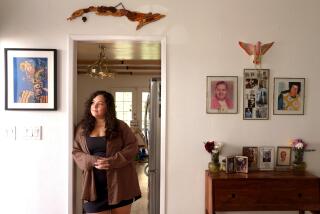SOUTHERN CALIFORNIA JOB MARKET: WORKING INTO THE NEXT CENTURY : GETTING HIRED, GETTING FIRED : PONDERING THE PINK SLIP : Being Fired Is Not Only Not the End of the World--It Can Be the Start
- Share via
Peter Lomenzo, a former senior vice president of Great Western Savings, was fired late last year after he and his superiors repeatedly clashed over business strategy. Although hurt and surprised, Lomenzo was hardly devastated.
Now the head of a Santa Monica industrial film company, he looks back with a philosophical shrug: “This kind of thing happens to a lot of good people.”
Indeed. The ax has fallen on Lee Iacocca, Sally Quinn and Steven Jobs. Billy Martin has been sacked a half dozen times. And the odds are increasing that you, too, will lose a job at some point in your career.
“More and more people are realizing that cradle-to-grave employment is a myth,” says Anthony Kane, owner and president of Univance, a Century City firm that specializes in finding jobs for fired or laid-off workers.
According to the Bureau of Labor Statistics, the average American today will work for 10 different employers, keep each job only 3.6 years and change his entire career three times before retirement.
“Today we say job security is three to five years,” says Robert D. Oberlander, a management consultant with RMA Consulting in San Marino.
It’s just not unusual for a person to be out of a job these days. Paul Hirsch, author of the book “Pack Your Own Parachute,” estimates that well over 2 million American workers saw their jobs disappear or deteriorate as a result of takeovers, forced mergers and other restructurings between 1984 and 1987.
Furthermore, Hirsch says that during the same time nearly 10,000 companies were sold to new owners, affecting millions of other workers. He foresees more of the same consolidation.
So, now that we know that the job scene is tough and getting even tougher, what do we do? A whole industry, drawn in large part from the ranks of the jobless, has sprung up to help today’s uneasy employees cope with their growing sense of vulnerability.
The message from these self-appointed gurus: Be prepared for the worst; learn from your mistakes and those of your co-workers, and, most importantly, do not think of yourself as a failure just because you are temporarily--and that is the key word--unemployed.
Consider how Billy Martin, whose career as a major league baseball manager has been nothing if not uneven, explains his six firings in the past 20 years.
While admitting that his work record is a bit spotty, Martin, who this season is on his fifth tour of duty with the New York Yankees, prefers instead to dwell on the positive. “All Billy says is that for every time he’s been fired, there’s been someone willing to hire him,” reports a Yankee spokesman.
Some of the new-age job advisers even tout getting fired as a potentially career-expanding and liberating experience.
“It can be a wonderful experience if you’re smart,” says Carole Hyatt, co-author of “When Smart People Fail” and a popular career-counseling lecturer. “When you get fired, you just have to remember that this world isn’t about winners and losers. It’s about learners and non-learners.”
Hyatt doesn’t have to look far to support her thesis.
Lee Iacocca found a rather nice job at Chrysler and was accorded sainthood status for a time after rescuing the formerly troubled auto maker from financial ruin.
After being sacked as co-anchor of the CBS early morning show in the mid-1970s, Sally Quinn returned to her award-winning feature writing work at the Washington Post--then turned her experiences into a best-selling book.
Steven Jobs hung around Apple Computer Co. for a few months after being dumped as chairman of the personal computer maker in 1985. But, within a few months, Jobs walked away from the company he had helped found in 1977 to start a new venture, Next Computer, which is expected to hit the market with its first product later this year.
In fact, for many people, getting fired does turn out to be the best thing that ever happened to them. Take the case of Linda Gottlieb, a 48-year-old former Phi Beta Kappa key holder in college, career fast-tracker, and all-around super-achiever.
After working for the same film executive for 20 years, Gottlieb was unceremoniously dumped in 1984 when the film company’s fortunes soured and the traits which had once so endeared her to her boss--a sharp tongue and tough mind--suddenly began grating on his nerves.
Abruptly set to sail in what were, for her, the uncharted waters of failure, Gottlieb quickly started looking for bearings and lessons. Within several months she teamed up with Hyatt, an old friend and New York City neighbor, to write “When Smart People Fail.” The book, which has sold 50,000 hard-cover copies, was recently released in paperback and is already on several best-seller lists.
But Gottlieb wanted to get back into film, so she started her own production company, Linda Gottlieb Productions. Her first film was “Dirty Dancing,” the teen blockbuster that has become the largest-grossing independently produced film ever, with total worldwide box office receipts of nearly $140 million.
Last month the film’s principal score, “Time of My Life,” won an Oscar. “I wouldn’t have done the writing, the film or any of it if I hadn’t been fired,” Gottlieb says. “I wouldn’t have had the courage.”
Although it is tempting to dismiss the post-firing successes of Iacocca, Quinn, Jobs and Gottlieb as yet more examples of their hyper-active need to succeed, there are plenty of other, less career-driven workers who report that being fired allowed them to get the job that they always wanted.
Lomenzo, the former Great Western vice president, is one of them.
“I wasn’t happy; they weren’t happy,” he recalls. Still the firing came as a huge shock, eroding Lomenzo’s self-confidence for a time and wounding his ego. A career-counseling and job-finding firm retained by the S&L; to help Lomenzo sent him to interview for a position with Media Design West, a small Santa Monica sales and industrial film maker.
Lomenzo, now Media Design’s president and co-owner, says the fit was perfect from the start. “I’m as happy as I’ve ever been,” he says. “You have to ask yourself where you would be the happiest and then find a job where you can do it.”
Co-authors Hyatt and Gottlieb argue that successfully emerging from a career failure requires a passage through five steps of grief, or mourning. The first is shock. Even if the handwriting was on the wall and the unhappy worker welcomes the firing, Hyatt and Gottlieb say the first reaction is usually disbelief, shock and numbness.
Fear, the second stage, quickly follows. The worries are usually financial, but often they can take on gargantuan proportions, such as worrying about ever working again. After fear comes anger and blame.
This is a tricky phase, the authors say, and many displaced workers often get trapped here, never fully able to get past their anger long enough to move on to a new part of their career.
The fourth phase is shame, the disapproval of others. Finally, the worker moves into despair, a feeling that the authors say strikes hardest at those whose egos are most closely aligned with their work.
Although a fired worker can jump from job to job quickly, Hyatt contends that a successful psychological coping with the firing requires passage through all five steps of grief over the lost job. “You expect people to go through stages of loss for a loved one, and with a career loss it’s the same,” Hyatt says. “You need to go through all the stages.”
More to Read
Inside the business of entertainment
The Wide Shot brings you news, analysis and insights on everything from streaming wars to production — and what it all means for the future.
You may occasionally receive promotional content from the Los Angeles Times.










